
The Royal Horticultural Society (RHS), founded in 1804 as the Horticultural Society of London, is the UK's leading gardening charity.

The Award of Garden Merit (AGM) is a long-established annual award for plants by the British Royal Horticultural Society (RHS). It is based on assessment of the plants' performance under UK growing conditions.

Kerria japonica, commonly known as Japanese rose or Japanese kerria, is a deciduous shrub in the rose family Rosaceae, native to China, Japan and Korea. It is named after William Kerr, who introduced the cultivar 'Pleniflora'. It is the sole species in the genus Kerria.

Dianthus gratianopolitanus, commonly known as the Cheddar pink or clove pink, is a species of plant in the family Caryophyllaceae. It is a herbaceous perennial, hardy to zones 4–8. It grows to a height of 0.5 to 1 feet, blooming from May to June. Flowers are fragrant and rose pink. Grows best in full sun, and has medium water requirements. Overwatering or poor drainage leads to crown rot, and plants do not tolerate wet winter soil conditions.

Brian Laurence "Bill" Burtt FRSE FLS, was an English botanist and taxonomist who is noted for his contributions to the family Gesneriaceae. In a career that spanned 74 years, he worked first at the Royal Botanic Gardens, Kew, and then at the Royal Botanic Garden Edinburgh (RBGE). He made numerous field trips to South Africa and Sarawak and described a total of 637 new plant species. Burtt is denoted by the author abbreviation B.L.Burtt when citing a botanical name.

Diascia is a genus of around 70 species of herbaceous annual and perennial flowering plants of the family Scrophulariaceae, native to southern Africa, including South Africa, Lesotho and neighbouring areas.

Cuphea ignea, the cigar plant, cigar flower, firecracker plant, or Mexican cigar, is a species of flowering plant in the genus Cuphea of the family Lythraceae. It is a tropical, densely branched evergreen subshrub. This species, native to Mexico and the West Indies, produces small, tubular, bright red to orange flowers. Each flower is tipped with a thin, white rim and two small purple-black petals. The flowers, which are attractive to hummingbirds and butterflies, are said to resemble a lit cigar, hence the name ignea, which comes from the Latin for "fire". The genus name Cuphea comes from the Greek word "kyphos" which means curved or humped; this is thought to refer to the shape of the seeds. The leaves are small, elliptical and of a bright green colour. It grows to about 60 cm (24 in).

Fothergilla major, the large witch alder or mountain witch alder, is a species of flowering plant in the genus Fothergilla, family Hamamelidaceae, that is native to woodland and swamps in the Allegheny Mountains and southern Appalachian Mountains of the southeastern United States. It is a deciduous shrub growing to 2.5 m with fragrant white bottlebrush flowers appearing along with, or before, the glossy leaves. The leaves often turn brilliant shades of red and orange in autumn.

Adiantum raddianum, the Delta maidenhair fern, is one of the most popular ferns to grow indoors. It is native to South America and its common name comes from its shiny, dark leafstalks that resemble human hair. It typically grows about 17–19 in (43–48 cm) tall and up to 22 in (56 cm) wide. In the wild, it is found on forest floors, rock crevices, river banks, coastal cliffs, and basalt banks along trails and streams. The triangular fronds are semi-erect in the beginning then droop gracefully as they age and can be up to 12 inches (30 cm) long by 6 inches (15 cm) wide. The genus name Adiantum comes from the Greek word "adiantos", meaning "unwetted".
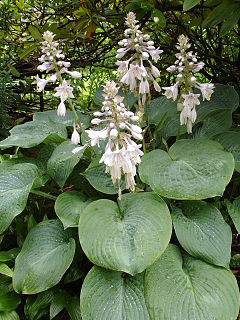
Hosta sieboldiana, Siebold's plantain lily, is a species of hosta native to Japan. A putative variety, Hosta sieboldiana var. elegans, has gained the Royal Horticultural Society's Award of Garden Merit, as has a putative variety of its synonym; Hosta fortunei var. aureomarginata, the gold-edged plantain lily. The cultivars 'Blue Angel', 'Blue Mammoth', and 'Olive Bailey Langdon' have also gained the RHS Award of Garden Merit.

Diascia rigescens, called the stiff twinspur, is a species of flowering plant in the genus Diascia, native to South Africa. It has gained the Royal Horticultural Society's Award of Garden Merit.
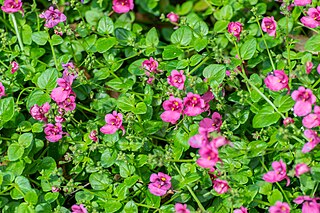
Diascia vigilis, called the twinspur or elf spur, is a species of flowering plant in the genus Diascia, native to South Africa. It has gained the Royal Horticultural Society's Award of Garden Merit.

Echeveria pulvinata, the plush plant, is a species of flowering plant in the genus Echeveria, native to southwest and central Mexico. A succulent, it has gained the Royal Horticultural Society's Award of Garden Merit. Its variety Echeveria pulvinata var. leucotricha, under the synonym Echeveria leucotricha, the chenille plant, has also gained the Award of Garden Merit.

Diascia barberae, called twinspur along with other members of its genus, is a species of flowering plant in the family Scrophulariaceae, native to South Africa and Lesotho. Its cultivar 'Blackthorn Apricot' has gained the Royal Horticultural Society's Award of Garden Merit. Many other cultivars that vary largely by the color of their flowers are available, including 'Ruby Field', 'Lilac Belle' and 'Rupert Lambert'.
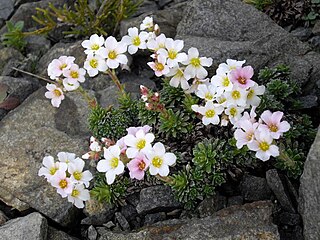
Saxifraga marginata, the Kabschia saxifrage, is a species of flowering plant in the family Saxifragaceae, native to southeastern Europe. It and its cultivar 'Balkan' have both gained the Royal Horticultural Society's Award of Garden Merit as ornamentals.

Soldanella villosa is a species of flowering plant in the family Primulaceae, native to the western Pyrenees. It has gained the Royal Horticultural Society's Award of Garden Merit as an ornamental.
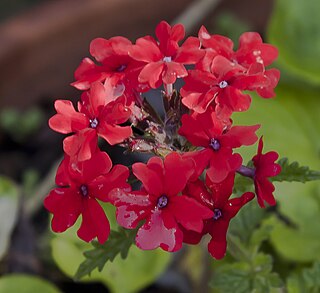
Verbena peruviana, the Peruvian mock vervain, is a species of flowering plant in the family Verbenaceae. It is native to Bolivia, southern Brazil, northern Argentina, Paraguay, and Uruguay, but not Peru, and has been introduced to scattered locations elsewhere, including the former Czechoslovakia, the US state of Illinois, and the Leeward Islands. Under the synonym Glandularia peruviana, its cultivar 'Balendpibi' has gained the Royal Horticultural Society's Award of Garden Merit.
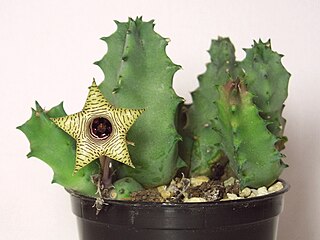
Huernia thuretii is a species of flowering plant in the family Apocynaceae, native to Namibia, and the Cape Provinces of South Africa. A succulent, as Huernia thurettii it has gained the Royal Horticultural Society's Award of Garden Merit.

Bistorta vacciniifolia, the whortleberry-leaved knotweed, is a species of flowering plant in the family Polygonaceae, native to Tibet and the Himalaya. Well-suited for clay soils, as its synonym Persicaria vacciniifolia it has gained the Royal Horticultural Society's Award of Garden Merit.
Stomatium alboroseum is a species of succulent plant in the family Aizoaceae, native to the Cape Provinces of South Africa. Under its synonym Stomatium niveum it has gained the Royal Horticultural Society's Award of Garden Merit.

















